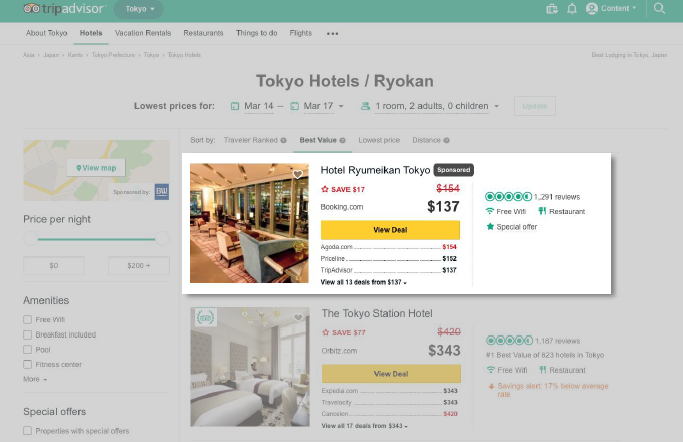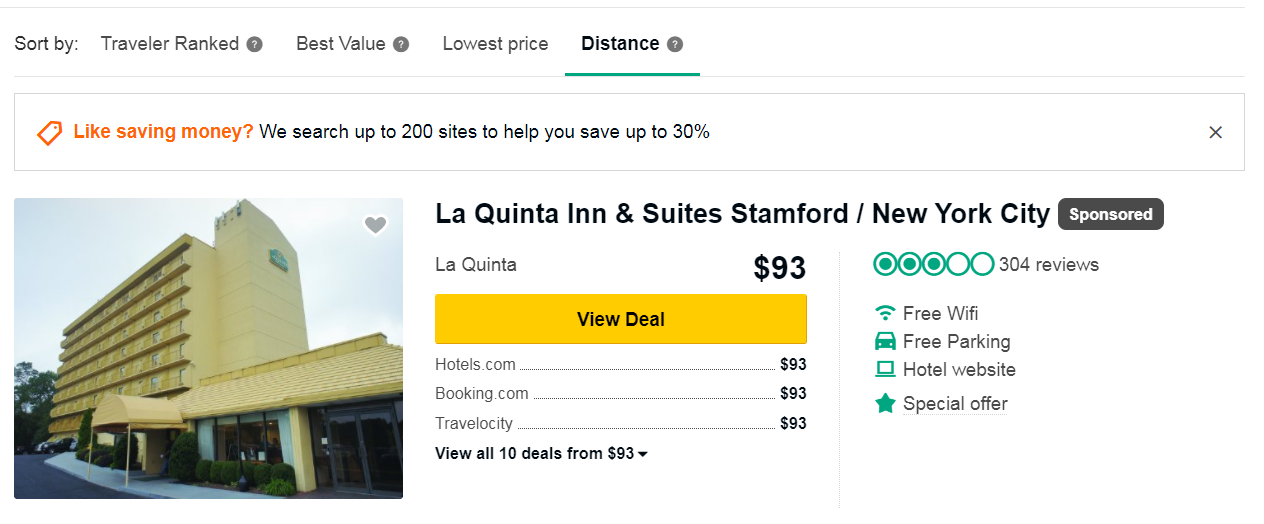
by Jason Price, EVP, HEBS Digital
Gaining visibility on websites such as Kayak, Expedia, and the largest travel website with over 570 million reviews and opinions across the globe, TripAdvisor, is a core component to any hotelier’s distribution strategy. Therefore, when TripAdvisor comes out with a new product, the industry is abuzz trying to understand implementation and determine if it’s a good fit for their property. Following the recent announcement of TripAdvisor’s new ad format called Sponsored Placements, we have outlined some of the top questions hoteliers may have and some tips for implementing this new offering.
First, What Are Sponsored Placements?
Sponsored Placements are sponsored listings that appear on top of the hotel search results when users search hotels in a destination. They appear on both the desktop and mobile sites, in theory providing additional exposure to the property.
Sponsored Placements offer advertisers:
- Top Placement –Sponsored Placements sit on top of search results, allowing hotels to get premium exposure.
- Highly Qualified – Since Sponsored Placements appear in search results, they will drive the right travelers to the property just as they’re making booking decisions.
- No Risk – Advertisers only pay for clicks and can cancel the campaign at any time.
- Easy to Use – Campaigns can be set up in minutes.
On a destination results page (i.e., New York, Mexico City, Tokyo, etc.), a Sponsored Placement ad gives the hotel advertiser first position in the search results, with a clear label of “Sponsored” in order to distinguish it. With an ad budget as low as $6.00 a day, any qualifying hotel can take advantage of Sponsored Placements and appear at the top of this results page.
Who Can, and Should Be, Participating in TripAdvisor Sponsored Placements?
With Sponsored Placements, TripAdvisor is giving hotels the opportunity to pay to be the top placement above Traveler Ranked, Best Value, and Distance results.
Sponsored Placements are currently available to properties that:
- Have claimed their listing on TripAdvisor
- Have a live Business Advantage subscription, and
- Share their live rates and availability on TripAdvisor (either directly through a Metasearch campaign, with Instant Booking or via OTA partners).
Are There Any Concerns Associated with Sponsored Placements?
From a cost perspective, it is important to know that all clicks count, as this is billed on a cost-per-click basis (CPC). This means that the property will incur costs even if users click outside of the actual Sponsored Placement listing. According to TripAdvisor, “A click is counted anytime a traveler clicks on your Sponsored Placement and is directed to another page, putting them one step closer to booking with you. For example, if a user saw your Sponsored Placement and then clicked your property’s name, photo, review count, or deal link, they would be taken to another page, so these would all be counted as clicks. A click on any of these pages will lead the user to the hotel’s property page. However, if the user clicks the heart shaped “save” icon, this would not be considered a click since he/she would be kept on the same page.”
The Stamford La Quinta Sponsored Placement, shown below, was a corporate, brand-driven effort that is most likely cost prohibitive for smaller hotel groups and individual properties. One of the biggest benefits of this program for branded properties such as the Stamford property below, is that they are almost always in parity due to the strict contracts many branded giants have with OTAs.
The Sponsored Placement below lists the rate in parity and the view deal button goes directly to the hotel’s landing page for the elevated chance of a direct booking. As we explored further, looking at New York, Boston, and London, the outcome for these hoteliers were not as favorable.
From the randomly selected examples shown below of an independent brand in New York City, Boston, and London, each hotel with the best of intentions is losing the direct customer in the Sponsored Placement.
Case 1
In case 1 the OTA is showing a lower rate than the official site, yet the hotel’s intent of Sponsored Placement is to get higher exposure for direct bookings. The hotel may be facing a need period and turned to the new ad format for a quick win, yet there’s a break in parity with the OTA showing a lower rate.
Case 2
In case 2 the hotel participates in the Sponsored Placement but there is no visible metaseach listing available. When we dug further there was no metasearch listing at all, which is not recommended as the hotel is making it easier for users to book through an OTA.
Case 3
In case 3 this London property faces the same outcome as the New York City Sponsored Placement. Either the property is unable to maintain rate parity suffering from a connectivity issue or just bad rate management, or equally likely some bad behaviors by wholesalers undercutting with a net rate to win the business.
What Should Hoteliers Do Now?
Like any new initiative, its always worth trying to see if it works for a specific property and it’s audience. However, unless eligible independent hotels have strict rate parity guidelines, they should reconsider their strategy before looking to move forward with TripAdvisor Sponsored Placements.
For those hotels that do qualify to participate, hoteliers should watch closely to see the case studies that get released from the participants. By running Sponsored Placements, there is a paid Sponsored Placement (CPC), most likely followed by a paid Metasearch listing (CPC) or the paid Instant Booking inclusion (CPA/OTA commission), plus the cost of the overall Business Advantage. The compounded costs have the potential to leave little opportunity to achieve a positive blended ROAS amongst the TripAdvisor initiatives.






